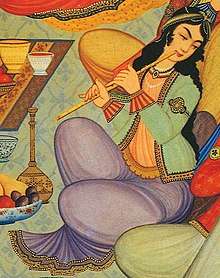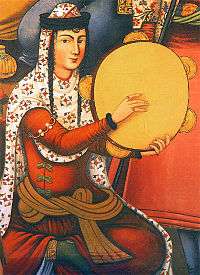Ney-anbān
Ney-anbān (Persian: نی انبان , numerous Latin spellings), is a type of bagpipe which is popular in southern Iran, especially around Bushehr. The term ney-anban literally means "bag pipe",[1] but more specifically can refer to a type of droneless double-chantered bagpipes played in Southern Iran. This is similar to the Bahrainian jirba played by ethnic Iranians in the Persian Gulf islands.
| Other names | نی انبان |
|---|---|
| Classification | |
| Related instruments | |
| Jirba | |
In Bushehr, the ney-anban is used to accompany sarva, the singing of free-metre couplets.[2]
Orthography
Latin spelling of the name of this pipe include: ney-hanbān, ney-anbun, ney ammbooni, nai-ambana hanbun, hanbuneh, nay-anban.[3]
External links
- Ney-anbān, video by Saeid Shanbezadeh
References
- Edward Balfour (1873). Cyclopædia of India and of eastern and southern Asia, commercial, industrial and scientific: products of the mineral, vegetable and animal kingdoms, useful arts and manufactures. Scottish and Adelphi Presses. pp. 23–. Retrieved 25 August 2011. - Nai, signifies a reed, pipe, &c, and Anban or Anbanah, a bag made of the skin taken entire otf a sheep. It is a musical instrument not often seen in Persia beyond the Garmsir (or "warm region") about Bushahr
- Ehsan Yar-Shater (1990). Encyclopaedia iranica. Routledge & Kegan Paul. p. 572. Retrieved 25 August 2011.
- Jarahzadeh, Kamyar. "Music and Race Politics in the Iranian Persian Gulf: Shanbehzadeh and "Bandari"". Ajam Media Collective. Retrieved 2016-01-26.
This article is issued from Wikipedia. The text is licensed under Creative Commons - Attribution - Sharealike. Additional terms may apply for the media files.
.jpg)

